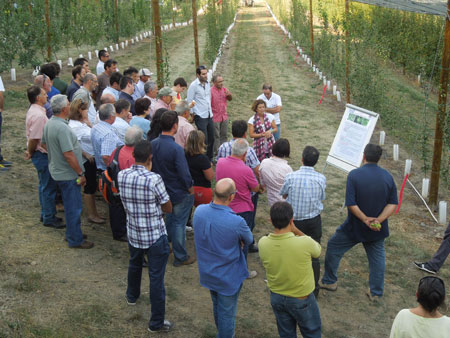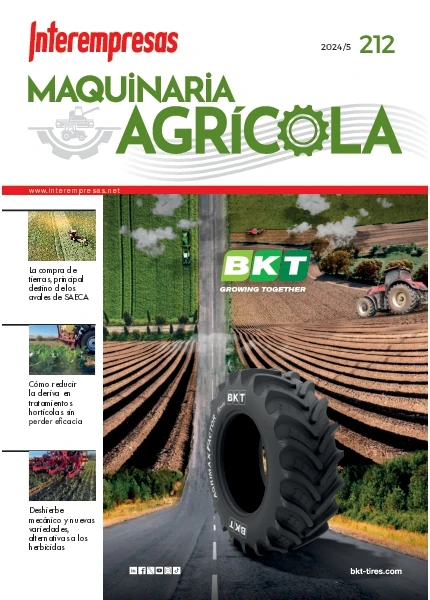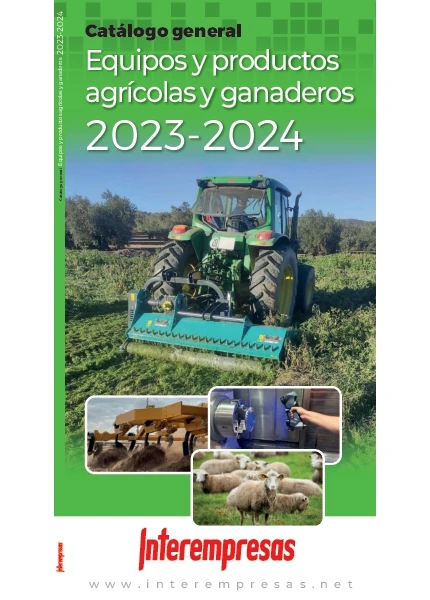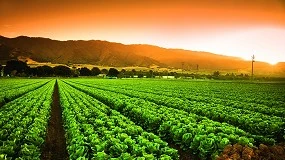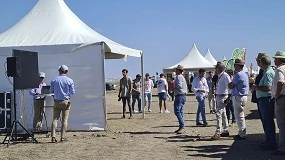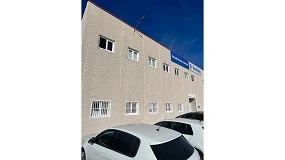The crop of the manzano in height would improve the sensory quality of the fruit and would reduce the imports
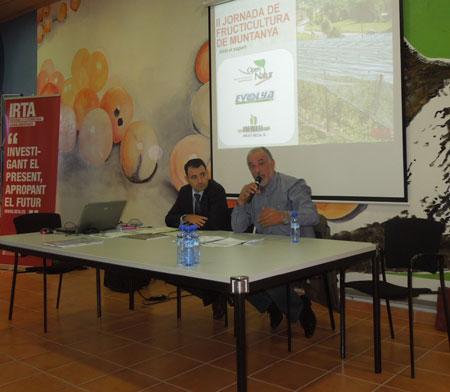
In Europe two highland zones stand out by the production of apple of high quality, are the Trentino-Sudtyrol (Italy) and the Alps of the Haute Durance (France). The alpine plantations of France, that situate between the 500 and 900 metres of altitude in a zone homogénea separated less than 100 kilometres between the most distant places (Sisteron and Gap-Embrun), starred the first of the technical reports of the II Day of Fruticultura highland, that took place, the past 21 September in the Pyrenean place of The The Pont of Suert, corresponding to the region Alta Ribagorza (Lleida). Like this it ensured it, Bruno Rivory, director of Avenir Qualité, Sisterón (France) during his conference 'The Production of apple in the French Alps'.
The alpine plantations French benefit of an insolación durable (300 days to the year) characteristic of the region of Provence. The contrast heat-cold in the previous period to the recolección provides an exceptional quality, when having of moderate maximum temperatures that make possible a photosynthetic activity sustained and favourable to the accumulation of azucares, according to Rivory. However the risk of frosts and of pedrisco is high (95% of plantations have of mesh antigranizo) and his protection puts up the price of the costs of production. The plantations situate in the skirts of the mountains in altitude and in small isolated zones so that they constitute a mosaic in combination with the crop of cereals or meadows. In definite, a zone that shows to perfection the strong bond between the floor, the climate and the quality of the apples of the Alps of the Haute Durance.
The ‘Golden' of the Alps, as it explained Rivery, has a prestigious fame because of his high content of azucares and to his high firmness. Besides, it is joined intimately to the characteristics of the half of crop, in particular to the floor and climate of the Alps situated largely on the departments of the Alps of Haute Provence and of the Hautes Alps. Both gather to some 170 producers, near of 4.100 hectares (of which 800 are of peral) and an annual production of 150.000 tonnes of apples. This represents near of 10% of the production of apple of France. The destination of the production is in the first place the French market, gone on down the exports to Spain, Germany, Great Britain, Belgium, Holland and Algeria, among others destinations.
The production of fruit in this zone traces back to the year 1358, developing to the years 30 and increasing, even more, from 1960 with the construction of the hydroelectric prey of Serre Ponçon, provista of a surface of 2.800 hectares and 1,2 million cubic metres of capacity. This made possible the protection in front of the freezing primaverales by means of the irrigation by aspersión. The expansion of the crop frutal in the years 1980 saw favoured by the crisis of the ovino, the low profitability of the cereals and the possibility to establish new zones of regadío devoted to the frutales. The high profitability of the variety ‘Golden' during several campaigns followed favoured his expansion, that in the actuality represents between the 60 and 80% of the production in function of the zone, gone on down the group ‘Delicious', ‘Gala' and ‘Reineta Grey'. The clone of ‘Golden' more cultured is the INRA-972, gone on down ‘Golden Smoothee'. Regarding the type of plantation, in the years 1990 initiated the use of the pattern MM-106 and plantations semi intensive (4,5-5 x 3 m) to happen later to intensive plantations with the pattern EM9 and densities of plantation of 2.000 trees/hectare (4 x 1,2-1,5 metres).

In the zone described, so alone 25% of the surface uses for agricultural ends and in her cultivate cereals, forrajes, other crops and frutales. The agricultural exploitations obtain all his income of the agricultural activity and/or grazier and can devote to produce only fruit and crops extensivos, or fruit, crops extensivos, forraje and livestock. 15% of the exploitations has more than 100 hectares, 30% between 50 and 100, 22% between 35 and 50, and 32% less than 35 hectares. The dimension of the plots oscillates between 0,5 and 4 hectares and the half performance in the case of the production of apple is of 40 to 60 tonnes/hectare. The available half price in plot oscillates between 0,25 and 0,45 euros/kilo, depending of the year, of the variety and the quality.
A total of eight Organisations of Producers (OP) produce 150.000 annual tonnes, being the most important the Alp'Union. Other companies of lower dimensions commercialise 10.000 additional tonnes. Regarding the marks of quality, in the year 1995 created , through the OP, an association of promotion for valorizar the production of the variety ‘Golden'. Later, this variety obtained the Label Rouge on 15% of the production and the certification of compliance of product on 40% of the same. Finally, it obtained the sign of I.G.P. for the apple of the Hautes Alps.
The Trentino-High Adige, where produces and commercialises 70% of the Italian apple
Italy is the fourth world-wide producer of apple after China, United States and Turkey. The Autonomous Region Trentino-High Adige is the main producing zone of Italy with near of 70% of the national production, specialised in the last years in the production and commercialisation of apple. Like this it explained it the doctor Paolo Lezzer, researcher of the FEM-IASMA, St. Michele, Trento (Italy), in the course of his exhibition 'The production of apple in the Trentino (Italy). The case Melinda: the apple of the Val gave Non'.
The Valleys gave Non and Sole constitute at present the reference in the production of apple in the Trentino, had to to a large extent to the popularity of the mark Melinda the most known and popular in Italy. This valley has a population of more than 50.000 inhabitants, a surface of crop of 59.600 hectares, of which 6.550 are frutales, 5.200 companies devoted to the production of apple and a production of 390.000 tonnes in the year 2011.
The specialisation to the crop of the manzano has been due to the favourable conditions edafo-climatic with which explains the Val gave Non, especially in the referred to the latitude, altitude, southward exhibition, low pluviometry estival, low relative humidity and a remarkable thermal sensors amplitude in the period of maduration of the fruit. This translates in a high aesthetic quality or of appearance (epidermis fine, no 'russeting' and high colouring in red varieties or bicolores) and organoléptica (pulp crocante and balance sugars/acidity of the fruit).
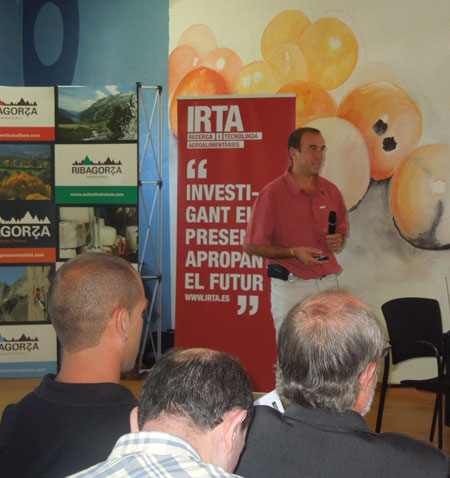
Melinda is a consortium of second degree that groups and represents to 16 cooperatives with more than 4.000 fruticultores associated, more than 1.000 workers, 6.511 hectares of manzano and a production of 372.000 tonnes in the year 2011, being ‘Golden' the most important variety. Melinda produces 60% of the apples of the Trentino and 15% of Italy. The value of the turnover rose in the campaign 2010-2011 to eight million euros.
The consortium initiates his activity in the years 1960 when there was in the valley more than 5.000 producing agriculturalists indiviudales of apple as well as a low economic performance. In the years 1970 created 40 warehouses of fruit that afterwards gave place, 10 years afterwards, to 17 cooperatives that competed between them and ocasionaban that the available prices went to the drop. In the year 1989 founded the Consorzio Melina and in the year 1994 centralised the sales to be able to commercialise through the big distribution. Eight years later, implanted the gestión centralised of all the sales with what put end to the internal competition between cooperatives. From the year 2002 Melinda is responsible of the collected of the fruit in the exploitations, transport to the head office, packaging and expedition. En el futuro they foresee commercial alliances with the big distribution.
The birth of the Consortium Melinda was due to the grave economic situation of the producers by the low prices perceived. The fact to treat of companies of similar dimension beside the altruistic spirit of the associated and the approach of aims on a long-term basis facilitated the creation of the same. The mark Melinda is the instrument that helps to the consumers to distinguish the apples produced by the consortium. 75% of the sales of Melinda allocate to Italy, what supposes 170.000 tonnes of ‘Golden' that is to say 40% of this variety consumed in Italy, being the most known mark and popular in Italy. In effect that one of each three ‘Golden' is Melinda. In the market of export stand out Germany, United Kingdom, Spain, Denmark and Belgium.
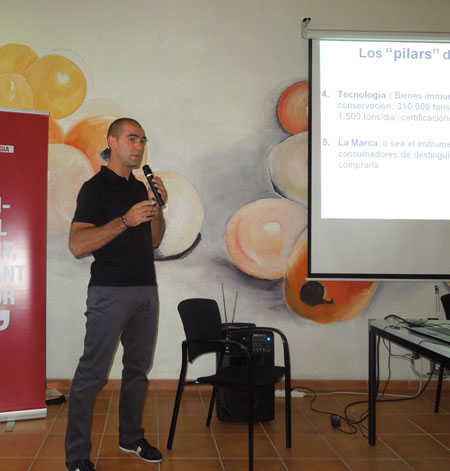
The pillars of the Consortium Melinda
These base in basing his production in a specific geographic zone that allows to produce a differential quality, have more than 4.000 associated of 16 cooperatives, 6.500 hectares of manzanos, more than 370.000 annual tonnes and more than 1.000 million fruit labelled under the denomination of origin D.Or.P. Mela Val Gave Non, Global GAP and Nature's Choice. The group has 1.000 customers, exports to more than 40 countries and the production allocates to more than 30 million consumers. The mark Melinda represents the strongest and sometimes the only advantage with regard to other concurrent in the market of the apple.
The half cost of production is of 0,25 euros/kilo. The half cost of settlement to the producer oscillated in the last 10 campaigns of 0,40 to 0,45 euros/kilo what equivale to 23.000 euros/hectare. 55% of the exploitations have a surface from among 0,5 and 3 hectares. On the contrary of what occurs in the consortium VOG (low part of Sudtyrol), the structure varietal of the consortium Melinda characterises by the strong predominance of ‘Golden' with 70% of the production, gone on down ‘Network Delicious', ‘Reineta Grey' and ‘Fuji'. En el futuro it will prioritise the reconversion to other varieties bicolores, being ‘Evelina' (mutation of ‘Pinova'), the main bet. With regard to the plantations, in the decades of the years 60 and 70 treated of plantations of low density (700-1.200 trees/hectare) and productions of 50 to 60 tonnes/hectare, to evolve in the following decades, and until the actuality, to plantations of high density with 3.000 to 7.000 trees/hectare (2,9-3,4 x 0,5 to 1 metres) and performances of 90 to 100 tonnes/hectare.
In the last years has set up the project agroturístico ‘Ambassadors of Melinda' that consists in creating in the Valleys gave Non and Sole a group of tourist installations that integrate the agriculture and the tourist activity. These installations offer to the customers a real experience of rural hospitality and llevar with the collaboration of The Strada della Mela, APT Val gave Non i l'Associazione Agriturismo Trentino.
'Why we matter so much apple in Spain? What sue our markets?'
Under this title, arrived the turn of words of Josep Faura, director of the Market of Fruit and Vegetables of Mercabarna, the one who realised a brief exhibition explaining the main appearances of Mercabarna in what to commercialisation of fruit and vegetables refers . Mercabarna Together with Mercamadrid are the two central markets that form part of the network of mercas existent on a national scale with a greater volume of sales. Mercabarna Is a mercantile anonymous society constituted by three public shareholders: the City council of Barcelona, the national company Mercasa and the region of the Barcelonan. This has a total surface of 86 hectares of which 45 are edificadas. It fits to stand out, like worrisome appearance, the descent continued of the consumption of fruit and vegetables in Spain, being Catalonia the third community with a consumption of 113 kilos/person-year. The traditional shop constitutes the most important sale with 28% gone on down supermarkets and autoservicios. Regarding the imports, the majority of fruit have diminished his volumes from the year 2007, had to mainly to the economic crisis; in particular the apple of import has happened of 55% (2007) to 35% (2011) of the apple sold in Mercabarna.
France constitutes the main origin of the fruit and vegetables that matter in our country. The greater prices of import of the apple, in the year 2011, corresponded to France for the variety ‘Pink Lady', New Zealand for ‘Gala' and Italy for ‘Granny Smith'. The minors were for Lleida with the variety ‘Golden'. The variety that sold more expensive was the ‘Green ‘ Doncella' of the mark Erruz. In the year 2011 commercialised 37.700 tonnes of apple, being ‘Golden' almost the half of the total gone on down the group of bicolores, with an available half price of 0,86 euros/kilo, being for the year 2003 of 0,76 euros/kilo. Regarding the origin of the fruit sold, this depends on the varieties. Like this, the ‘Golden' comes from, mainly, of Lleida, Gironinginga, France and Italy. The ‘Delicious' proceed of Lleida and Italy and the bicolores of the group ‘Gala', of Lleida, Gironinginga and Italy. The ‘Granny Smith' usually matters of Italy and France.
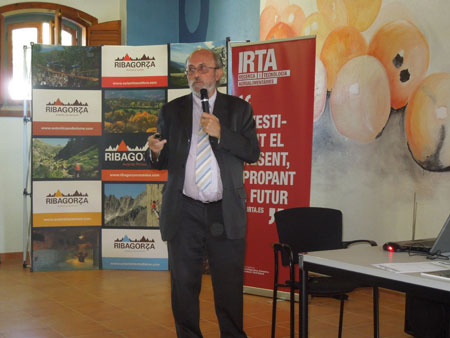
Like conclusion, add that the apple of import has had and still has a strong presence and leadership in Mercabarna. In the last years, shows a declining tendency by the effect of the crisis, that has affected more to the apple of greater price, that is to say, the one of import. It buys , of other countries, mostly apple marquista, being Perlim, Melinda and Val Venosta the most important marks in the variety ‘Golden'. The sellers value of these marks the commercial seriousness of the producing companies, the typification and perfect identification of the product, the maintenance of the quality along the year and of the campaigns and a quality gustativa differential, since they produce mostly in zones of height. En el futuro, produce an offer tipificada and of quality in our country, situating the crop of the manzano in zones of height, could contribute to the economic and social development of the same and to reduce the imports. This would make possible to offer a product of high quality, in accordance with the exigencias of the consumer, of greater vicinity and more sustainable from the environingingmental punto, when shortening the distance production-consumer regarding the apple of import.
'The production of apple in Spain and the experience of Alta Ribagorza'
The production of apple in Spain finds in clear recession, when having lost, the half of the same from the year 1985. In the actuality, this does not reach the 500.000 annual tonnes. Like this it ensured it the doctor Ignasi Churches, manager of the Program of Evaluation of New Varieties and Portainjertos of the IRTA, with reason of the exhibition 'The production of apple in Spain and the experience of Alta Ribagorza'. In opinion of the speaker, the main cause has been the difficulty of our productions to compete in a global market where finds present apple of import of numerous countries, mainly of France and of Italy. These countries have a better production organised and when being situated in zones of greater altitude and latitude, the quality of the apple, in particular the texture and the colour are upper.
Since the crop of the manzano adapts well to the highland zones, where expresseses better his potential of quality, thought that evaluate his behaviour in the region of Alta Ribagorza could be interesting to pose it like alternative and/or complement to the current agricultural activity of highland zones based mainly in the production grazier. It was thus that in the frame of the agreement between the IRTA (Departament of Agriculture of the Generalitat of Catalonia) and the Association for the Development of the Ribagorza Romance (ADRR), initiated , three years ago, a pilot experience to evaluate the behaviour agronómico and the quality of 14 commercial varieties of apple and two of pear in an experimental plot situated in the place of Llesp. Simultaneously, and in the frame of the same project, realised during the period 2009-2010, the prospección of different autochthonous varieties of manzano and peral in the area of performance of ADRR that comprises different municipalities of the regions of Alta Ribagorza (Catalonia) and of the Ribagorza (Aragon).
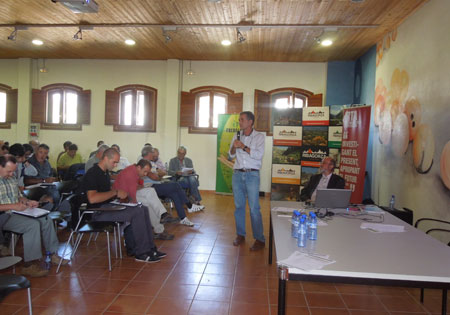
The results until the fourth year of plantation (2012) show that the productions are similar to the obtained with the same varieties in the zones of plain. In the second, third and fourth year have obtained for diverse varieties productions of 18, 40 and 58 tonnes/hectare, respectively. The calibrate of the fruit can be inferior if it does not adjust well the load of the tree, especially in varieties of lower size of fruit like the ones of the group ‘Gala'. The main differential appearance regarding the zones of plain has been a better colouring of the fruit, that is to say, a more intense colour and brilliant, what has done that the differences between clones of ‘Gala' have been minors. In all the varieties evaluated, the texture of the pulpa is more crujiente, substantial and with greater flavour. The second differential appearance has been a slower maduration that in the zone of plain, what has translated in a wide window of harvest for all the varieties. This is due to that the firmness diminishes slowly and even with high values of starch (8-9) this keeps on being elevated. It is thus that the toning of the expensive less coloreada of the epidermis (background colour) to green-yellow constitutes a good indicator of the state of maduration and of the moment of start of the harvest.
In definite, so much the presentation of the fruit like his instrumental and sensory quality, have seen improved by the altitude. From the punto of technology of the crop the condition by moteado is upper that in warm zones, what requires an efficient strategy of prevention. Likewise, the risk of frosts increases with regard to zones of plain. The limitation of the crop produces in varieties of recolección late, that is to say back to ‘Fuji', since from principles of November exists the risk of descent of the temperatures underneath of -5 °C.
In the afternoon, realised a visit of the assistants to the experimental plot situated in the place of Llesp. The assistants could know “in situ” the activities realised from his plantation in March of the year 2009, the characteristics of the plantation and the productions of the different varieties. Only they had recolectado the varieties of the group ‘Gala'.
For each one of the two groups of assistants realised three stops or stations. The first, where explained the characteristics of the plantations, varieties evaluated and a summary of the results obtained. It visited the plantation of autochthonous varieties being able to observe the first productions in some of them. The explanation was realised by Ignasi Churches. In a second station exposed , by part of Laura Torguet, the main appearances referred to the technology of the crop as they are the protection of the same in front of plagues and illnesses, the protection antihelada and against the pedrisco by means of meshes, the credited, the fertirrigación and the maintenance of the floor. In the third station explained in detail how realise the learning of the trees in central axis, from the plantation until the tree adult, and how and when realise the podas in green. The explanation ran to charge of Ramón Girabet.
